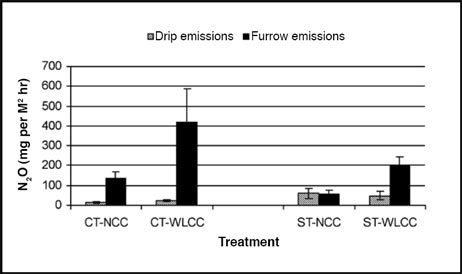| • Table of Contents • |
Winter/Spring 2007 - Vol. 7/No. 2
Subsurface drip irrigation, cover crops and conservation tillage effects on greenhouse gas emissions.
Issue of Concern
California is the second largest emitter of greenhouse gases in the U.S., of which an estimated 8% of total state carbon dioxide (CO2) and 59% of nitrous oxide emissions (N2O) are from agricultural activities. Increased pressure on water supplies, water and air quality, and the need to mitigate greenhouse gas emissions necessitates the adoption of more sustainable farming practices to address these issues. Subsurface drip irrigation (SDI) is one promising practice that uses less water, eliminates irrigation tail water return and has the potential to reduce CO2 and N2O emissions.
Greenhouse gases in agriculture
CO2 and N2O emissions from the soil are primarily the result of the activities of naturally occurring soil microorganisms. On-farm activities such as tillage, irrigation, and high inputs of carbon and nitrogen to the soil are known to influence soil microbial activity and processes related to trace gas emissions. Thus, limiting or changing these activities has the potential to reduce the CO2 and N2O emissions from agricultural soils. The majority of soil microorganisms are most active in moist and warm soils, the dominant soil condition in the summer when the fields are irrigated. The most common irrigation practice in California row crop systems is furrow irrigation (FI). Recently, subsurface drip irrigation (SDI) is gaining popularity as prices become more economical and equipment becomes more durable. Under FI, the entire soil profile is wetted to near saturation to achieve uniform water distribution. This can often lead to an excess of water beyond crop needs leading to lower water use efficiency. In SDI, water delivery is minimized to an area of the soil profile directly beneath the crop. The confined spatial delivery of water in SDI limits microbial activity to the small area directly around the drip line. Furthermore, fertilizer can be delivered in small increments through the drip tape (fertigation) directly to the plant roots, increasing nitrogen (N) use efficiency, leaving less N to be transformed to N2O by microorganisms.
Findings
We are currently wrapping up a two-year study designed to examine the potential of SDI to reduce greenhouse gas emissions. In addition, we are examining the effects of winter legume cover crop (WLCC) and conservation tillage (CT) to reduce soil emissions of CO2 and N2O under FI and SDI. These treatments were compared to no winter cover crop (NCC) and standard tillage (ST). Carbon dioxide and N2O emissions from soil were monitored bi-weekly starting in the winter of 2005.
CO2 Emission
Annually, the SDI treatments had a 4% lower CO2 emission rate compared to the FI treatments. During the growing season, total CO2 emissions were lower in the SDI treatments and were not different during the winter season compared to FI. In general, the FI-CT plots often showed higher CO2 emissions. This may have been a result of a high density of weeds in the FI-CT plots, adding to the amount of CO2 from root respiration, as well as sustained higher soil moisture content under CT. In the SDI-CT plots, weed populations were low and there was little difference in CO2 emissions between tillage treatments.
 Figure 1. Nitrous oxide emissions from July 6, 2006 by treatment. |
N2O Emissions
Of the 100 lbs. N/acre fertilizer application, 18% was lost as N2O from the FI treatments compared to 4% N lost as N2O in the SDI treatments. The highest N2O emissions were found in the FI-WLCC treatments, while the lowest N2O emissions tended to be in the SDI-NCC treatments.
The WLCC treatment across both irrigation types consistently showed higher N2O emissions compared to the NCC treatment (Figure 1). Cover crops can be crucial in reducing winter runoff and in increasing carbon sequestration. However, this and other studies have shown that they may also increase N2O emissions. This may be a result of the addition of N to the soil in the form that can then be transformed into N2O under ideal soil moisture and temperature. Using a non-N fixing cover crop such as cereal may help reduce this effect.
Summary
Our results suggest that the conversion to SDI from FI has the potential to reduce greenhouse gas emissions. Although our findings suggest that growing a leguminous cover crop may enhance N2O emissions, this effect is greatly reduced under SDI and is less than the more common FI-NCC system (Figure 1). The difference in emissions between irrigation treatments was much more profound for N2O than for CO2, with SDI having lower emissions. Although both gases are significant contributors to global warming, N2O is 300 times more potent than CO2. Agriculture accounts for more than half of N2O emissions in California and the world. The adoption of SDI technology is increasing in the Central Valley, but still represents less than 15% of all irrigation despite some of the demonstrated benefits of water savings and reduction in greenhouse emissions. The upfront costs and maintenance requirements of SDI may be part of the reason for its slow adoption. We hope that our fall 2007 results on the economics of SDI will help growers evaluate the benefits of alternative irrigation systems.